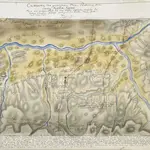Document

The low lying flat land called Kolla Noari or Qwälla, Western Ethiopia
This manuscript map depicts the low lying flat land called Kolla Noari or Qwälla in western Ethiopia. Georg Wilhelm Schimper spent more than 40 years in Abyssinia collecting specimens of plants hitherto unknown to Europeans and mapping the geology and topography of the region. Schimper, born in 1804, studied Natural Sciences at Munich University from 1828 to 1829 and in 1830 he met Eduard Rüppell, the first naturalist to travel in Ethiopia. In 1831, in the service of a scientific collection society in Germany, Schimper left for his first botanical collection expedition to Algiers and in 1835 for a second expedition to Egypt, the Sinai and the Arabian Peninsula. From there he moved to Massawa in January 1837 and travelled to Tigray where he was received by the local ruler, Dädjazmach Webe Haile Maryam, who allowed him to settle in Adwa. Between October 1837 and May 1855 Schimper undertook various expeditions as far north as the Märäb River and south into the Täkkäze and Semien mountain regions, the prolific results of which made him the famous botanist. On the orders of King Tewodros II, Schimper had to stay in Gafat in Bägemder under ‘house arrest’, but in 1864-65 was able to spend time working on his topographical map of Bägemder. In 1867 Schimper and his family, together with the whole community of European and Indian hostages in Gafat, were forced to march to Mäqdäla where they were finally rescued on 12th April 1868 by the British military expedition under the leadership of General Sir Robert Napier. After his release, Schimper returned to Adwa and worked on the two maps of Adwa and Kolla Noari. This map is part of the papers by Georg Wilhelm Schimper, which he presented to the British Museum in 1870 and now are located at British Library, BL Add 28505 and 28506.
The British LibraryGeorg Wilhelm Schimper
1868

